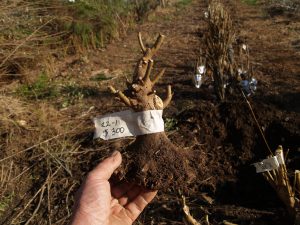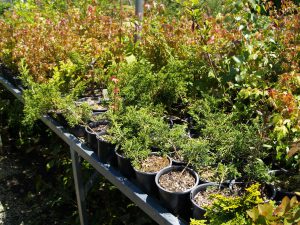Shibui Bonsai, a small nursery based at Yackandandah in North East Victoria, grows and develops a range of species to provide high quality pre bonsai and starter trees. Neil has over 45 years of experience growing bonsai and has been growing field grown pre-bonsai material for the past 25.

At Shibui Bonsai our emphasis is on developing trees with the best potential. We carefully root prune at each repotting to encourage lateral rootspread as the first stage of developing bonsai with great nebari. Regular pruning in the field and in the nursery builds trees with taper and dynamic trunk movement.

Bonsai starters
Our main emphasis has been on growing and supplying traditional bonsai favourites such as Trident and Japanese maples, Chinese elms, Black pines and Shimpaku juniper but we also grow smaller numbers of other species with potential as bonsai.
More recently we have been growing small numbers of Australian native trees, many of which are proving quite adaptable to bonsai.
Some of you may have seen our trees for sale at major bonsai shows and events. We will continue to bring great stock to you when we can, but for those who just can’t wait and those from areas we don’t get to, Shibui Bonsai is open by appointment only. So to avoid disappointment, please contact us before making the trip. Group visits from Bonsai clubs are most welcome……
For those who are not able to get to the nursery we can pack and post trees to most eastern states of Australia.

Hi, Neil.
I am following all your threads on Ausbonsai regarding your Maples.
I have a few 14 year old fieldgrown Maples in pots that I bought two years ago that will have to be repotted and the roots cut back. Because of all the repotting that will have to be done the next two months I would also like to repot my Maples now. They all lost their leaves about three weeks ago.
I have never bare rooted any tree and the experience is going to be very scary.
Temperatures here never go below 1 degrees Celcius. Average temperatures for July is about 4 degrees up to 22 degrees Celcius.
Celtis bud out end July and Acacia middle August.
They will be fine?
Lennard
Your conditions are quite different to what we have here Lennard but if your tridents are leafless it should be fine to repot now. Tridents are really tough and can tolerate quite a lot of root reduction and I have not yet seen a beginner cut off enough to endanger a tree. Keep a look out for a post showing root reduction of field grown maples when we dig the trees this year to see what can be done.
neil
Nice website. Appreciate the time and effort that goes into producing your field grown stock; quality is impressive. I assume you do not/cannot ship to the US due to import/export restrictions, but please let me know if it is otherwise. I’m always on the lookout for gradually increasing/improving my collection (now at 12 trees + 30-35 two year old saplings as a side experiment). Its harder to find sources for field grown bonsai stock here in the US than you would think.
Hi Richard. thanks for the flattering comments re stock. I am surprised to hear that sources in the US are hard to find. I have not ivestigated shipping to US because I easily sell all my stock here in Aus. If you can find a way to get it to you (legally) I will happily supply you.
Neil
Hey there guys,
How would one go about purchasing? Do you send pics of stock before purchase?,
Hi Darren, Thanks for your interest in Shibui Bonsai. Anyone can select trees from our current catalogue then email Neil@shibuibonsai.com.au to check if the tree is still available. I’m happy to supply further pictures of selected trees if you need to check any aspects or areas that are not visible. If you already know what you want let me know what species, size and price range, etc and I will see if we have something in our stock. Neil
Great website – could I order a copy of your current catalogue. I would be interested in some natives as it is too hot in Broken Hill for maples etc.
Regards
Dennis
Hi Dennis. You should be able to find links to the current catalogues on the catalogue page. I also have plenty of starter plants of most of the bonsai favorite species. I do have some natives as starters in 11 and 15 cm pots but very few larger or better developed natives at this stage. I am growing more but it will take a few years to get them to advanced prebonsai stage. you can email neil@shibuibonsai.com.au to get further info or pics of the natives I have available at the moment.
Neil
Just wanted to give some positive feedback, i would like to thank Neil, as from the very beginning he was a pleasure to go see, very knowledgable and more than happy to give a beginner like me a bit of advice
Cheers again
Thanks for the article and especially the photography on Digging Ground Grown Field Grown Trees for Bonsai. I have a few questions after reading. Please assume healthy deciduous trees.
When you root prune as hard as shown…
1. Do you often return the tree trunk back to the ground for continued growth?
2. Can the roots be repeatedly cut back hard in ramification stages to produce an excellent Nabari….and returned to the ground for growth?
3. Once you hard prune the roots…does this stop further trunk diameter growth?
And last question,
4. Once you hard prune the roots close to the trunk…does that stop all further growth (in diameter) of that root that was cut? Does that root no longer fatten up?
Thanks…..well done on the article.
Hi John,
You must be growing a few trees in the ground because you are asking some very pertinent questions. Hope I can give some help.
1. I do often return trees to the ground. When we dig trees they are assessed into 3 categories – A. Trees are ready for sale or to start developing branching. These go into grow containers. B. Trees that appear to have little prospect of becoming good bonsai. These are consigned to the firewood or burning pile. C. Trees that will probably benefit from further time in the ground. These are replanted in the grow beds for a second chance. Hopefully there are more As than Cs and less B type trees each year.
2. roots can, and should, be cut back hard regularly when developing in the ground and when growing in containers. Frequent pruning produces lots of fine feder roots close to the trunk where a bonsai needs them. If by ramification stages you mean creating and ramifying branches then yes you should also prune roots hard every year or 2. However you cannot create branches and branch ramification while trees are growing in the ground (at least not trident maples) because they just grow too fast and branches get too thick and heavy.
3. Pruning roots will not stop trunk growth. As soon as the new roots start to grow new growth will start above ground as well. It is this above ground growth that drives trunk thickening. More roots = more growth = more trunk thickness. However there is more to growing good bonsai than trunk thickness. We value taper maybe even more than just thickness in a trunk. Taper is driven by having several upright shoots on the trunk. After some are pruned off you will have both taper and movement and character in your trunk.
4. Pruning roots will not stop that root from thickening. New roots will grow from the cut end. As those new roots grow and thicken so will the old part of the root above – just as it happens above ground with trunk and branches.
5. I do probably more frequently put trees into containers than back in the grow beds but that is because I have the experience to do a good job first time. I always put any trees back into the ground when I think they will improve by doing so. Trunks will continue to thicken whenever there is growth above. Growth above ground depends on roots providing food and water so more root development = more above ground growth = more trunk thickening.
Hope that helps somewhat,
Neil